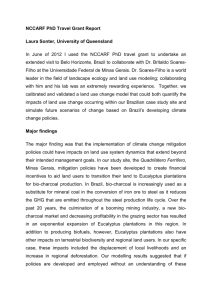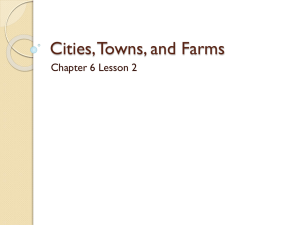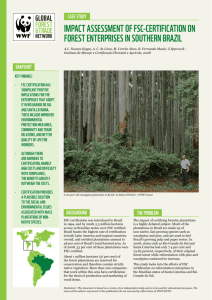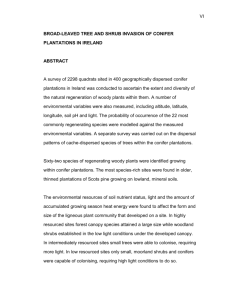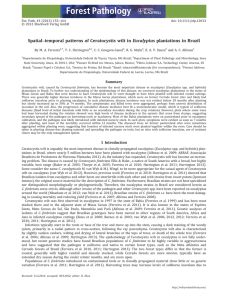Brazil Case Study - B-REED
advertisement
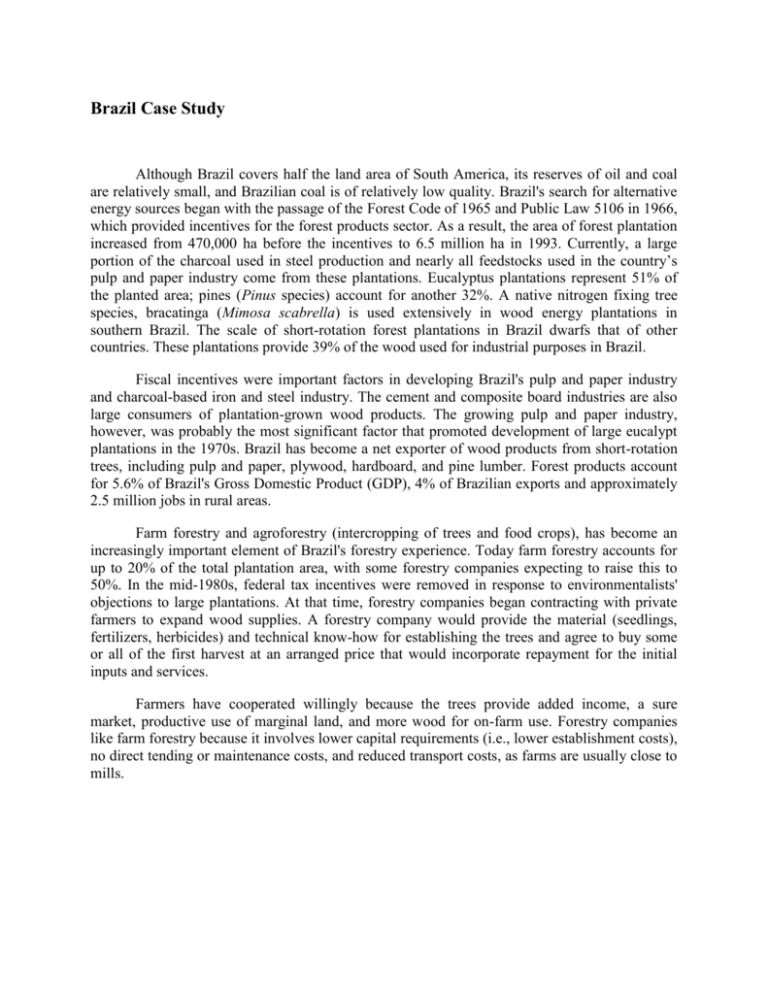
Brazil Case Study Although Brazil covers half the land area of South America, its reserves of oil and coal are relatively small, and Brazilian coal is of relatively low quality. Brazil's search for alternative energy sources began with the passage of the Forest Code of 1965 and Public Law 5106 in 1966, which provided incentives for the forest products sector. As a result, the area of forest plantation increased from 470,000 ha before the incentives to 6.5 million ha in 1993. Currently, a large portion of the charcoal used in steel production and nearly all feedstocks used in the country’s pulp and paper industry come from these plantations. Eucalyptus plantations represent 51% of the planted area; pines (Pinus species) account for another 32%. A native nitrogen fixing tree species, bracatinga (Mimosa scabrella) is used extensively in wood energy plantations in southern Brazil. The scale of short-rotation forest plantations in Brazil dwarfs that of other countries. These plantations provide 39% of the wood used for industrial purposes in Brazil. Fiscal incentives were important factors in developing Brazil's pulp and paper industry and charcoal-based iron and steel industry. The cement and composite board industries are also large consumers of plantation-grown wood products. The growing pulp and paper industry, however, was probably the most significant factor that promoted development of large eucalypt plantations in the 1970s. Brazil has become a net exporter of wood products from short-rotation trees, including pulp and paper, plywood, hardboard, and pine lumber. Forest products account for 5.6% of Brazil's Gross Domestic Product (GDP), 4% of Brazilian exports and approximately 2.5 million jobs in rural areas. Farm forestry and agroforestry (intercropping of trees and food crops), has become an increasingly important element of Brazil's forestry experience. Today farm forestry accounts for up to 20% of the total plantation area, with some forestry companies expecting to raise this to 50%. In the mid-1980s, federal tax incentives were removed in response to environmentalists' objections to large plantations. At that time, forestry companies began contracting with private farmers to expand wood supplies. A forestry company would provide the material (seedlings, fertilizers, herbicides) and technical know-how for establishing the trees and agree to buy some or all of the first harvest at an arranged price that would incorporate repayment for the initial inputs and services. Farmers have cooperated willingly because the trees provide added income, a sure market, productive use of marginal land, and more wood for on-farm use. Forestry companies like farm forestry because it involves lower capital requirements (i.e., lower establishment costs), no direct tending or maintenance costs, and reduced transport costs, as farms are usually close to mills. Site and Species Selection When the incentives were introduced, planners had no ecological zoning or no comprehensive body of scientific work to help them select the best species for each region and site. Plantations were established in savanna-like regions in the central-west and southeast, primarily because of low land prices there. In these areas, the climate, low annual rainfall and five- to seven-month dry season were unsuitable for Eucalyptus grandis and E. saligna, the species planted. These conditions, together with the distance of sites from potential markets, resulted in major failures. In some cases, plantations were never well established because of limited groundwater availability or the presence of subsurface gravel layers that roots could not penetrate. Such failures led to greater recognition of the importance of the site characteristics of existing vegetation, slope, chemical and physical soil characteristics, availability of water and energy, and distance from consumers. In the early years, also, native forest ecosystems were cleared and burned to make room for "reforestation" plantations. When that was banned, plantations were established on abandoned or degraded agricultural lands or on land previously occupied by eucalypt stands. Rising land prices in industrialized regions further reduced opportunities for expanding plantation area near existing forestry mills. Given these restrictions, companies increasingly promoted higher productivity through genetic improvement and careful soil management. In Brazil, the most widespread commercial eucalyptus species is E. grandis. The national and state governments and forestry companies also con-duct genetic improvement programs for E. saligna, E. urophylla, E. camaldulensis, and E. citriodora. Controlled hybridization, cloning and micropropagation have been used to produce homogeneous stands that provide high productivity, natural resistance to pests and diseases, and uniform raw material. E. camaldulensis has become the preferred agroforestry species because of its narrower canopy, which minimizes shading of nearby food crops, with beans the preferred intercrop. Bracatinga, a native nitrogen-fixing tree, has become a major plantation species in the cold highlands of southern Brazil. Although it shows lower yields than eucalyptus (about 13 steres/ha/year on a seven-year rotation), many farmers prefer bracatinga because it can be grown at much lower cost, requiring no fertilization, tending or control of leaf-cutting ants (an expense incurred with eucalypts). Bracatinga stands are generally planted at densities approaching 20,000 seedlings/ha and later thinned to 3,000-4,000 seedlings/ha. By harvest time, bracatinga seeds are naturally incorporated into the soil, with no need for replanting. Bracatinga has been collected locally by provenances and, like eucalyptus, has become the subject of genetic improvement trials. Plantation Establishment, Tending and Protection Plantations have been established from vegetatively propagated clonal "seedlings" grown in dibble tubes filled with vermiculite or a mixture of vermiculite, compost, and ground charcoal. The nursery process for eucalyptus requires 70-80 days, with seedlings spending the first half of the nursery period in shade, the second half in the sun. Most planting is done by hand. Early operations employed harrowing, plowing and furrowing without regard to slope or runoff direction, causing an enormous amount of erosion. Such unsustainable site preparation was abandoned in favor of cultivation techniques that minimize soil and nutrient loss through the use of herbicides, followed by furrowing along topographic contours. Short-rotation coppice plantations generally use spacings of 3 m x 3 m (1,100 plants/ha) or 3 m x 1.5 m (2,200 plants/ha). The early fiscal incentives favored denser plantations, but many with densities of 5,000-10,000 trees/ha failed due to high mortality, small final diameter, and an excessive proportion of bark to wood. Brazilian experience indicates that wider spacings lead to greater mean annual increment growth, reduced wind damage, and permit easier harvesting, weed control, and intercropping of agricultural crops. Spacing is adjusted to produce trees of a specified diameter at harvest, given site quality, plant genetics and rotation period. Each seedling normally receives an initial 120 g of N-P-K fertilizer. Early operations applied a standard fertilizer formulation to sites; later companies developed specific formulations for each site, species, hybrid and clone. In eucalyptus plantations, weed control is performed twice a year, and is considered critical until canopy closure, usually after the first two years. In early Brazilian plantations, weeds were controlled by discing between rows and hoeing within rows. Discing, however, caused erosion (since rows were usually oriented downslope) and cut the trees' surface roots, retarding growth and sometimes causing death. Later, plantation managers adopted methods that did not disturb the ground surface, such as herbicides (applied just before planting and again at 4-8 months) and mowing. Research found that sheep and cattle could be used for weed control, and that intercropping with agricultural crops could eliminate the need for tending operations during the first year. Resistant clones, hybrids and species are planted to control fungal diseases. Leaf-cutter insects pose a more serious threat: when established, they can destroy a young plantation in a few days. Plantations require careful monitoring to detect colonies at an early stage. In 1992, dodecachlor-based baits were banned, replaced by sulfluramid-based bait. Other local insects, particularly the families Lepidoptera and Coleoptera, have caused problems for some eucalypts. Control initially involved pesticides, but environmental damage, growing insect resistance to pesticides and their high cost limited their use and effectiveness. Insect problems were partially alleviated through better site-species matching and silvicultural practices such as pruning. A major breakthrough occurred with the recognition of biological controls, which now provide the main form of insect control. For example, many insects are controlled by intermixing native vegetation with the exotic eucalypts, which helps maintain local bird populations. Growth, Production, and Harvest Eucalyptus harvesting has become increasingly mechanized, with felling usually done with chain saws. An average operator cuts 120 trees/day. Crowns are lopped off; trees can be cut into sections or left whole, depending on the equipment used to move trees to the landing. Loading is done with grapple loaders. Nearly 70% of transport to mills is by truck, the remainder by rail. The haul distance averages 70 km one way, with maximum hauls in the range of 200-300 km. Transport fuel expense remains a major concern to forest companies. Bracatinga is mainly grown on smaller farms, and harvested by axe. Logs are cut into 0.8-1.2 m lengths with a minimum 4 cm diameter. Horse carriers or tractor trucks transport logs to the roadside. Logs typically are sold from the roadside. Productivity of short-rotation, large-scale eucalyptus plantations in Brazil has increased dramatically over the past two decades. In some areas, annual yields rose from 35 steres/ha/year in 1970 to 70 steres/ha/year in 1993. This resulted from a substantial research effort, particularly in genetics and biotechnology, reinforced by better silviculture and management practices. Yields from farm forestry remain somewhat lower (with lower establishment costs). The costs of growing one hectare of eucalyptus on a seven-year rotation vary widely depending on the region, soil fertility, species, and technology. In 1989, logging and transport costs, for example, varied with region and terrain from 51%-70% of total delivered wood costs. Because the planting and cultural costs of bracatinga were lower, logging and transport costs could comprise up to 93% of total operational costs. After harvest, logging slash is burned or used for energy. If the plantation employs coppicing for regeneration, the area is disced and broadcast fertilized. Stump sprouts normally appear within 2-3 weeks. In cases where the stand is replanted, stumps are removed or covered with soil, and seedlings planted in the rows between stumps. In the 1970s and 1980s, yields declined for eucalyptus stands established by coppicing. Contributing factors included use of inappropriate sites and provenances, large genetic variation of planting materials, high incidence of canker and leaf cutter attacks, and the damage to coppice stumps caused by harvesting. Most of these problems were later addressed. Lower costs of coppice establishment (about 10% of planting costs) partially offset the reductions in yields (approximately 15% for the first coppice and 30% for the second). Due to the rapid improvement of genetic stock, however, Brazilian companies have shifted to renewing stands after the first harvest. Observations Brazil's experience indicates that success requires direct links between plantation establishment and an existing or planned end user. Success also requires a fully funded government oversight organization and educational and research institutions. As a result of considerable pressure from environmental groups to limit further eucalypt plantation establishment, national, state and municipal forest legislation in Brazil is becoming more restrictive. Critics of monocultural eucalyptus plantations maintain that these plantings reduce biodiversity, encourage soil erosion, reduce soil nutrients, lower local water table levels and compete with food crop production. To minimize the environmental impact of eucalyptus plantations, Brazilian researchers proposed the following actions: • Use ecological zoning for better species selection and management. • Augment biodiversity through increased use of agroforestry systems. • Conduct research on the ecology of native forest species that may substitute for eucalyptus. • Implement more biological (vs. pesticide-based) pest control. • Reduce the use of mechanized techniques on steep slopes. • Institutionalize a process of environmental impact assessment. As a result, forest companies have moved toward sustainable management of other forest resources (including water, air quality, soil, wildlife, recreational and scenic values) in addition to wood products. Many of the large companies now include strips or blocks of native vegetation within plantations. Tree farmer programs, which bring small farmers into the companies' supply planning and operations, are becoming more important supply sources. These small farmer programs are seen as promoting rural economic development, reducing migration to urban areas, and limiting the concentration of land ownership by large forest companies. The companies are also conducting agroforestry research to gain the biological, technical and economic information needed for such programs. The companies have improved their public image through agroforestry and local education programs, and donations toward preservation of endangered ecosystems. There has always been intense public scrutiny of commercial bracatinga harvests. Harvesting is permitted only for mature stands and only on a sustained-yield basis. Widespread clearcutting of bracatinga was banned to reduce soil erosion and preserve water tables. The policy has stabilized fuelwood supply during a period of rising demand. This has helped raise the real price of bracatinga and the income of thousands of small farmers.
